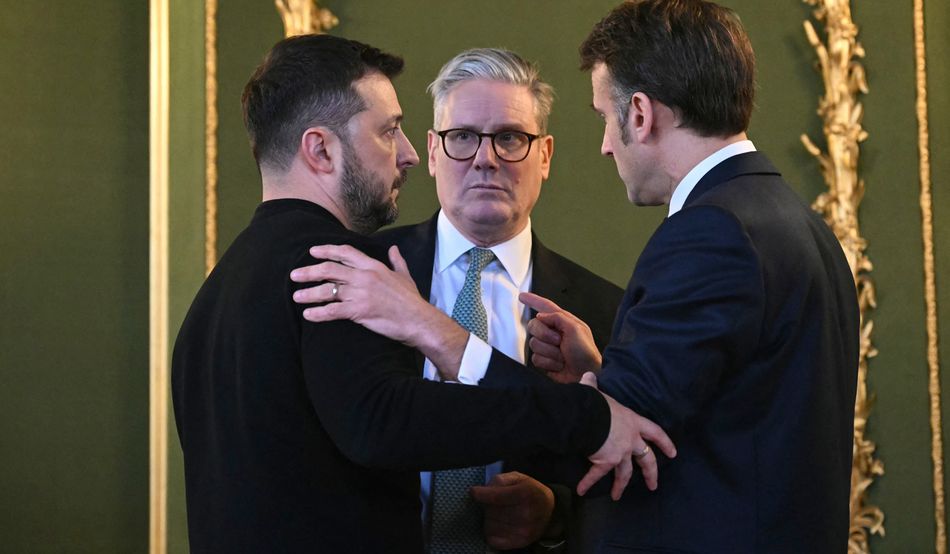It has been known for a long time that Russia poses a threat to Europe—first and foremost to countries in the north and east, starting with Ukraine, but also beyond. It has been known that Vladimir Putin’s imperial ambitions drive him to re-establish a sphere of influence in eastern Europe, stretching from the Baltics to the Balkans. And it has been known that Moscow will pursue this militarily where it must, and through hybrid tactics where it can.
In countries where the vast majority of the population is adamantly anti-Russian, including in the Baltics, Poland and, of course, Ukraine, the Kremlin understands that no amount of disinformation and election meddling will do the trick; military means are necessary to achieve its imperial conquest. Indeed, Russia’s military mobilisation is obviously not aimed “only” at conquering eastern Ukraine: its defence spending this year is expected to be higher in purchasing power terms than that of all EU member states combined.
In countries where public opinion is divided or more malleable—Georgia, Moldova, Romania, Bulgaria—hybrid tactics may suffice. Russian-sponsored disinformation campaigns, election meddling and electoral fraud in Moldova and Georgia last year, as well as the interference in the Romanian presidential election, whose first round was cancelled by the constitutional court, provide evidence both of these hybrid tactics and of their success or near-success.
Such tactics are far cheaper and more efficient than outright war, and are directed not only against potential victims of Russia’s imperial appetites, but also to soften the resistance of countries in western and southern Europe, as well as the United States. Russia seeks to weaken, if not destroy, the EU and Nato, and so it supports nationalist, far-right and populist parties—like the AfD in Germany, Italy’s League or the National Rally in France—that will do the job on its behalf.
In some ways, then, Europeans have known for years what they must do. Since Russia’s annexation of Crimea in 2014 and the beginning of war in eastern Ukraine, European defence has slowly been awakening after its quarter-century holiday from history. Defence budgets across Europe have steadily grown, and today European countries spend an average of 2 per cent GDP on defence. During the last decade, they began talking more about security, slowly reversed the downward trend in defence spending and established mechanisms for greater coordination and cooperation within the EU, and between it and Nato. And yet, in retrospect, this was only a fraction of what was necessary.
It is only now, faced with a mounting threat from Russia—and an abandonment at best, or betrayal at worst, by the US—that real momentum is picking up. This was in some ways predictable—but the toughest challenges arise from the unexpected twists that led to Europe’s present predicament.
The geographical divide in Europe tells us that the real driver of this rise in defence spending is Putin, despite what Donald Trump may boast. Countries in northern and eastern Europe spend well over 2 per cent GDP on defence, with Poland approaching 5 per cent. Others further to the south and west continue to lag behind: in Spain and Italy, for example, defence expenditure still hovers well below 2 per cent. It has been much easier for leaders in the north and east to make the political case for defence: the argument is not that the US demands it, but that Russia threatens them. In western and southern Europe, further removed from the front line, prioritising defence over housing, healthcare or education, for instance, has been and remains a harder sell to the public.
During this time, growing awareness of Russia’s threat also led to steadily improving relations between the EU and Nato. Given the increasing and multifaceted Russian threat, haggling between Euro-Atlantic institutions made less sense after 2014. Petty institutional turf wars were largely cast aside and they began cooperating systematically over hybrid threats, military mobility and defence industrial matters, among other issues. In the last three years, with Nato’s enlargement to include Sweden and Finland, and Denmark’s entry into the military dimension of the EU’s Common Security and Defence Policy, the overlap between the two sets of institutions has increased significantly.
For well over a decade, Europeans have also known about the US’s drive to disengage from European security—although they have selectively forgotten it at times. The tune coming from Washington started changing during Barack Obama’s presidency, when the US began prodding Europeans to spend more on defence. The argument was that Washington had to pivot towards Asia—specifically China—and Europeans had to become more capable of looking after themselves, shouldering more responsibility for their own protection from Russia, as well as from the instability in north Africa and the Middle East. Europeans listened, but did little—not least because the US, despite its apparent Asia pivot, remained embroiled in the security crises in and around Europe, in the Caucasus, Ukraine and, above all, in the Middle East.
The first Trump administration sent a starker message. Trump came across as mildly hostile to Europeans and, all in all, uninterested in their security. No wonder that in those years Europeans began talking about their strategic autonomy, a notion first elaborated in the 2016 EU Global Strategy and then popularised by French president Emmanuel Macron. Europeans still privileged working with their allies, first and foremost the US through Nato, but they realised that they needed to become more capable, and even ready to act alone to protect themselves if and when the US refused to help.
The election of Joe Biden in 2020 and Russia’s full-scale invasion of Ukraine in 2022 saw such ideas for European strategic autonomy shelved. Biden was embraced by Europeans, at least until the chaotic withdrawal from Afghanistan and the Aukus nuclear submarine crisis in the summer of 2021. Transatlantic cooperation about the war in Ukraine—from sanctions policy to military support for Kyiv—was tight. French-sounding notions of autonomy were sidelined, to avoid irking Washington.
This would prove to be a mistake. Since 2022, the EU has made important steps on defence—for instance, channelling military assistance to Ukraine, jointly procuring ammunition for Kyiv, and planning for a European defence industrial policy. However, this did virtually nothing to counter an increase in European defence dependence on the US. The Stockholm International Peace Research Institute calculates that the US accounted for 55 per cent of Europe’s weapons imports between 2019 and 2023, up from 35 per cent in the previous five years.
Up until the eleventh hour, Europeans actually increased their defence dependence on the United States
This increased dependence was the result both of necessity and of amnesia. It was necessary because European countries had to replenish their armament stocks quickly, given the outflow of weapons to Ukraine. They therefore bought what was available on the market, and very often this was American. And with a war on their continent, Europeans relied on the institutional structures best suited for the purpose of territorial defence. That, unquestionably, was and remains Nato.
Yet Europeans also wanted to forget the four-year nightmare of Trump’s first presidency and to believe it was over for good. The idea that Trump could cause a renewed or even deeper transatlantic rift was ignored. Thinktank, media and policy planning circles talked incessantly about “Trump-proofing” Europe, especially in the last year of the Biden presidency, when Trump’s return became more and more likely. But hardly any concrete plans were made, especially on security.
Europeans would have been far more prepared had they gradually pursued their strategic autonomy over the last decade. But up until the eleventh hour, they actually increased their defence dependence on the US. They succeeded in shouldering an ever-growing defence burden, including on Ukraine—where the European share of military support now exceeds that of the US—but they never tried to be autonomous from the US.
Given the relative decline of American power and its growing competition with China, Europe perhaps should have foreseen and prepared for a gradual US disengagement from European security. The rapid pace and hostile character of this disengagement was harder to predict.
The US administration seems intent on betraying Ukraine, seeking a bilateral deal with Moscow, sowing division among Europeans by supporting far-right parties and attacking the EU, which Trump views as having been invented to “screw” the US. His disdain for European liberal democracy and integration mirrors that of Putin’s. It is no surprise that Washington and Moscow support the same nationalist and Eurosceptic parties that erode European cooperation and integration from within.
Europe now needs to do much more to defend itself, while also reducing its dependence on American troop presence and weapons systems.
In the worst case scenario, Washington would actively turn against Europe by weaponising its dependences on the US
In the best of circumstances, the US might be disinterested in or unavailable for cooperation. The Trump administration has voiced its opposition to providing security guarantees for Ukraine, including by ensuring a backstop for a possible European reassurance force in the event of a ceasefire. Ideally, such a backstop would ensure the capacities that Europeans lack, deter an eventual Russian provocation and backfill the gaps in northern and eastern Europe if troops from these countries were moved to Ukraine.
But the US’s disengagement may not stop there. If it ceases to see Russia as a threat and if its commitment to Nato and European security wanes further, it is hard not to imagine this partial withdrawal of US troops from European Nato countries in the coming months or years.
In the worst case scenario, Washington would actively turn against Europe by weaponising its dependences on the US. Ukraine tragically got a sense of what this could mean when the US temporarily suspended its intelligence cooperation and Elon Musk appeared to consider switching off Kyiv’s access to Starlink, the satellite system that has ensured communications for the Ukrainian armed forces on the battlefield. Musk has since denied that he would use the system as a bargaining chip—but Washington could pursue similar tactics to arm-twist Europeans in other areas, such as trade or the regulation of technology.
Europe cannot entirely wean itself off US defence overnight, and may not need to do it completely. After the plummeting of transatlantic relations in the first months of the second Trump administration, American voters may push back against Trump’s policies, constraining the administration and preventing it from entirely destroying the post-1945 and post-1989 order that the US had built and led. But this is likely wishful thinking, and the US’s betrayal could be long-term and real. Europeans should hope for the best but plan for the worst. That means filling the gaps America would leave.
The continent’s vulnerabilities are no secret. Without the US, Europe would have gaps in intelligence, surveillance and reconnaissance (ISR); air defence and missile systems; artillery, including deep precision strike capabilities; strategic enablers including heavy-lift transport aircraft and air-to-air refuelling. Its capabilities are limited in satellites and military mobility, as well as cyber, electronic warfare and AI—notably as it applies to autonomous weapons systems such as drones.
Taken collectively, Europe’s defence industry—including companies like Airbus, BAE Systems, Leonardo, Rheinmetall, Saab, Safran and Thales—could make a real contribution to many of these areas, either alone or in cooperation. But to produce at scale they will need the aggregation of demand, long-term contracts and, above all, far more financing.
Money will soon start flowing. The European Commission has proposed the relaxation of the EU’s fiscal rules, exempting total defence expenditure for four years. This could generate an extra €650bn for the sector, with a large chunk of it coming from Europe’s largest economy, Germany, given the country’s agreement to revise its constitutional debt brake for defence spending and for investments in infrastructure and green technologies.
The European Investment Bank is revising its rules to ensure that defence can be increasingly supported; for example, by agreeing to finance small and medium enterprises (SMEs) in the security and defence industry, and by expanding its definition of the kind of dual-use goods and infrastructure that it can fund.
European countries are used to seeing the US as a reliable ally and the transatlantic bond as unshakable
There are also discussions on the development of an intergovernmental bank for rearmament, constituted by willing and able European nations—perhaps including the UK—and modelled on the European Bank for Reconstruction and Development, which was founded in 1991 to support countries of the former Eastern bloc.
Moreover, the EU will develop a financial instrument worth €150bn to fund an EU defence programme, similar to Sure, the pandemic unemployment insurance scheme. It is not yet clear whether EU-wide defence funds will support only defence capacities made in Europe, as favoured by France, or could also back projects involving third countries, as pushed for by Germany, Italy and Poland, among others. If the latter, such third countries could be restricted to European Nato allies such as the UK and Norway, or expanded to include Turkey and perhaps Canada—or even the US itself.
Therein lies the most complicated problem. European countries are used to seeing the US as a reliable ally and the transatlantic bond as unshakable. This has been the story since 1945. The policy choices made, including in the existential area of defence, were premised on this conviction. It never occurred to European governments or companies that the US and its defence-industrial complex could one day be turned against them—but if there is even the tiniest possibility that it could, Europe’s defence and technology choices need a rethink.
In some areas—capacities that Europe either lacks or doesn’t have enough of—governments could safely continue to acquire weaponry from the US. Europe’s production capacity for ammunition and tanks is severely stretched, and while it should fill gaps by bolstering its own production, there is no reason not to also buy from others. Once such capacities are acquired, the US would have less leverage over Europe (apart from the need for maintenance and spare parts). The same could be said for technology, including in civilian areas such as cloud services, where the data belongs to the buyer and it is possible to prevent the tech provider from just switching off the service.
However, there are other capacities where the risks of working with the US are much higher. Some fighter jets, helicopters and air defence systems continue to rely on American communications support, information sharing and software updates. Rumours that the US has a secret “kill switch” that could immobilise such weapons systems are unproven, but reveal the loss of trust in the transatlantic relationship. Likewise, the potential weaponisation of satellite services such as Starlink should push Europeans to accelerate significantly their investments in alternatives.
The hardest question of all is the nuclear one. Europe has for decades been protected by the US nuclear umbrella—the security guarantee that America would defend its allies if attacked. If the US were to withdraw its protection, including in the nuclear domain, Europe would be exposed. Europeans cannot replace the US’s nuclear capability in the near-term, but they also cannot ignore the reality that they might need to. In March, Macron raised once again the question of a European nuclear deterrent and the role that France and the UK could play as the only nuclear powers on the continent. They should continue discussing what steps to take. This could also involve joint military exercises and training with nuclear weapons. It is only on this basis that Europe could put itself in the position to make sensible choices in the nuclear field in future.
A final set of questions regards the institutional underpinning of this European defence momentum—that is to say, how will it be organised?
The European Commission must facilitate financing and can induce cooperation, but the EU is not equipped to take decisions with the speed and level of ambition necessary to confront the urgent challenge Europeans face. Plus, Viktor Orbán’s Hungary and Robert Fico’s Slovakia appear to work more for Putin’s Russia and Trump’s US than for Europe. So the EU alone is not the answer.
Neither is Nato. Non-EU Nato nations such as the UK and Norway—possibly Turkey and Canada too—are involved in European defence. But the urgent reaction now required has been triggered because the US, by far the most important Nato ally, is checking out of European security.
For the time being, momentum is being driven by a coalition of willing and able countries, shepherded by Macron and Keir Starmer, with the next German chancellor Friedrich Merz and Polish prime minister Donald Tusk also expected to play important roles. The leaders of this coalition in the making have met repeatedly both in person and online in recent weeks to discuss urgent questions regarding Ukraine and European defence more broadly. Eventually, something more structured must be set up to ensure that work takes place between one summit and the next. The Quad—a diplomatic partnership between Australia, India, Japan and the US—may prove a good initial model to replicate.
It will take time for European countries to be safe without the US security umbrella, and in the short term they should explore all possible ways to strike a new, sustainable and secure transatlantic bargain to keep it in place. But it would be madness to discard the possibility that this effort might fail.
The only sane course of action is not just to spend more money on what is possible today—to invest more in weaponry, to cooperate with allies—but to invent new kinds of institutions, formats and ways for states to work together. Planning for a future in which the US might no longer be there for us means creative solutions are needed. In short, it means thinking about the impossible.















